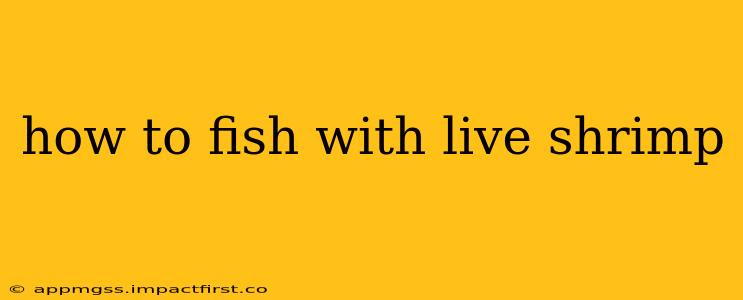Live shrimp are a highly effective bait for a wide variety of fish species, making them a popular choice for anglers of all skill levels. Whether you're targeting speckled trout, redfish, flounder, or even snook, understanding how to properly use live shrimp can significantly increase your chances of a successful fishing trip. This guide will cover everything from selecting and rigging your shrimp to mastering the art of the cast and retrieve.
What Types of Shrimp are Best for Fishing?
The best type of shrimp for fishing depends heavily on the species you're targeting and the location you're fishing. However, generally, larger shrimp are more attractive to larger fish.
- Size Matters: Larger shrimp (1-2 inches or even larger) are often more appealing to bigger fish, while smaller shrimp can be effective for smaller species.
- Freshness is Key: Using fresh, lively shrimp is crucial. Shrimp that are dead or dying will be less effective and may attract unwanted attention from smaller, less desirable fish.
How to Keep Live Shrimp Alive?
Keeping your shrimp alive until you're ready to use them is vital. Here are some tips:
- Aerated Container: Transport your shrimp in a well-aerated container, such as a bucket with an aerator or a specially designed live shrimp container.
- Cool Conditions: Keep the container cool, but avoid freezing the shrimp. Cooler temperatures will help them stay alive longer.
- Avoid Direct Sunlight: Direct sunlight can quickly kill live shrimp, so keep them in the shade.
How to Rig Live Shrimp for Fishing?
There are several effective ways to rig live shrimp, each with its own advantages and disadvantages. Choosing the right rigging method will depend on your target species and the fishing conditions.
Float Rig:
This is a popular method for fishing in shallower waters. A small bobber keeps the shrimp suspended at the desired depth. This is great for attracting fish that are feeding in the water column.
Carolina Rig:
The Carolina rig is excellent for fishing in deeper water or areas with heavy vegetation. The weight helps to keep the shrimp on the bottom, while the leader allows for a more natural presentation.
Fish-Finder Rig:
This rig features a small weight above the hook, which helps to keep the bait suspended just off the bottom, ideal for fish that feed near the seabed.
Simple Hook Rig:
This is a simple method that involves hooking the shrimp through the head or back. It’s quick to set up but can be less effective if the shrimp dies or gets torn off.
How to Cast and Retrieve Live Shrimp?
- Casting: Cast your bait gently to avoid injuring the shrimp. The shrimp should land softly in the water.
- Retrieving: A slow, steady retrieve is often the most effective. Vary your retrieve speed and technique to see what works best. Consider pausing the retrieve at times to allow the shrimp to naturally move and entice fish to strike.
What is the Best Time to Fish with Live Shrimp?
The best time to fish with live shrimp is often during the early morning and late evening hours, when fish are most active. However, this can vary depending on the species and location. Consider the tidal patterns too, as these can heavily influence fish activity.
What are Some Common Mistakes to Avoid When Fishing with Live Shrimp?
- Using dead or dying shrimp: This is a major mistake. Fresh, lively shrimp are much more appealing to fish.
- Using the wrong hook size: The hook size should be appropriate for the size of the shrimp and the species of fish you're targeting.
- Retrieving too quickly: A slow and steady retrieve is usually more effective than a fast one.
- Not paying attention to tides and currents: Understanding how tides and currents affect fish behavior is essential for success.
Where Can I Buy Live Shrimp for Fishing?
Live shrimp can be purchased at many bait and tackle shops, marinas, and even some grocery stores. Check with local resources to find a reliable supplier of high-quality live shrimp near you.
By following these tips, you can significantly improve your success rate when fishing with live shrimp. Remember that practice and experimentation are key to mastering this versatile bait and consistently landing more fish. Happy fishing!
